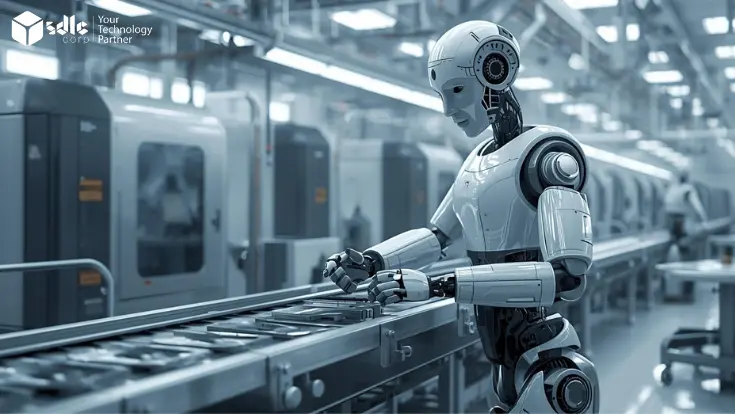Introduction
Procedural generation has emerged as a transformative technique in game development, allowing developers to create vast, intricate worlds with minimal manual effort. This method involves algorithms and rules that automatically generate content, making it possible to produce everything from terrain and textures to entire game levels and narratives. Unreal Engine, a powerful platform developed by Epic Games, provides robust tools for implementing procedural generation. This article explores the tools and techniques available in Unreal Engine for procedural generation, the benefits of using these methods, and why hiring skilled Unreal Engine developers is essential for maximizing the potential of your projects.
Unreal Engine Game Development Company

What is Procedural Generation?
Procedural generation refers to the algorithmic creation of content using predefined rules and parameters. Instead of manually designing every aspect of a game, developers can utilize procedural generation to create assets, environments, and gameplay experiences dynamically. This approach has several advantages:
- Efficiency: Reduces the time and effort required to create large amounts of content.
- Replayability: Provides unique experiences for players each time they play, enhancing engagement.
- Scalability: Allows for the creation of expansive worlds without the need for extensive manual labor.
Key Tools for Procedural Generation in Unreal Engine
Unreal Engine offers various tools and features that facilitate procedural generation. Here are some of the most important ones:
1. Blueprints
Blueprints are a visual scripting system within Unreal Engine that allows developers to create gameplay mechanics and other functionalities without writing code. This tool is particularly useful for procedural generation, as it enables developers to set up algorithms and rules visually. Key features include:
- Node-Based Interface: Use nodes to define logic and processes for generating assets and environments.
- Event-Driven Programming: Create events that trigger procedural generation, allowing for dynamic content creation during gameplay.
- Reusability: Blueprint scripts can be reused across different projects or levels, streamlining the development process.
2. Landscape System
The Landscape system in Unreal Engine allows for the creation of large outdoor environments. This tool can be enhanced with procedural generation techniques to create realistic terrains:
- Heightmaps: Use heightmaps generated by algorithms to define the elevation of the landscape, creating varied terrain features like mountains and valleys.
- Foliage Tools: Automate the placement of trees, rocks, and other environmental elements, ensuring a natural look and feel.
3. Procedural Mesh Generation
Procedural Mesh Generation allows developers to create custom meshes at runtime. This feature is invaluable for generating unique assets and environments based on algorithms. Key capabilities include:
- Vertex and Triangle Control: Define the vertices and triangles of a mesh dynamically, enabling the creation of complex shapes.
- Dynamic Updates: Alter mesh properties during gameplay, allowing for real-time procedural changes to the environment.
4. Material Editor
The Material Editor in Unreal Engine enables developers to create complex materials using a node-based interface. Procedural textures can be created through the Material Editor to enhance the visual quality of generated assets:
- Noise Functions: Use noise algorithms to create varied textures that can be applied to procedural meshes, ensuring diversity in appearance.
- Parameterization: Adjust material parameters at runtime, allowing for dynamic changes based on game conditions.
5. Level Streaming
Level streaming is a technique used to manage large game worlds efficiently. Unreal Engine allows developers to load and unload levels dynamically based on player location. Procedural generation can be integrated with level streaming to create expansive, seamless environments:
- Dynamic Loading: Load generated content on the fly, creating a sense of a vast, living world.
- Optimization: Improve performance by only rendering parts of the world that the player can see.
Unreal Engine Game Development Company

Techniques for Procedural Generation
1. Noise Functions
Noise functions are mathematical algorithms used to create random variations in procedural generation. They can be applied to various aspects, including terrain, texture, and gameplay mechanics. Common types of noise include:
- Perlin Noise: Often used for generating smooth landscapes and textures, Perlin noise creates natural-looking randomness.
- Simplex Noise: An improvement over Perlin noise, Simplex noise provides better visual quality and performance.
2. L-systems
L-systems, or Lindenmayer systems, are a mathematical formalism used to model the growth patterns of plants and fractals. By defining a set of rules, developers can generate complex plant structures procedurally:
- Growth Algorithms: Create realistic vegetation by defining growth rules that mimic natural processes.
- Modular Design: Use L-systems to create reusable plant components that can be dynamically placed in the game world.
3. Cellular Automata
Cellular automata are grid-based systems where each cell’s state changes based on predefined rules. This technique can be used for generating organic shapes, such as caves or biological structures:
- Rule-Based Generation: Define rules that dictate how cells interact, resulting in intricate patterns and formations.
- Dynamic Evolution: Allow the environment to evolve over time, creating a sense of change and growth.
4. Genetic Algorithms
Genetic algorithms are optimization techniques inspired by natural selection. These algorithms can be employed to refine procedural generation by iteratively improving designs based on specific criteria:
- Adaptive Design: Create assets or environments that evolve over time based on player feedback or performance metrics.
- Diversity: Ensure that generated content remains varied and interesting by exploring a wide range of potential solutions.
The Benefits of Hiring Unreal Engine Developers
While Unreal Engine provides powerful tools for procedural generation, the expertise of skilled developers is crucial for maximizing these capabilities. Here’s why hiring Unreal Engine developers is a smart investment:
1. Specialized Knowledge
Experienced developers possess a deep understanding of Unreal Engine’s tools and features, allowing them to implement procedural generation techniques effectively. Their expertise can lead to more polished and innovative results.
2. Custom Solutions
Every game is unique, and hiring an Unreal Engine developer for hire enables you to create custom procedural generation solutions tailored to your specific project requirements. This customization can significantly enhance gameplay and player engagement.
3. Performance Optimization
Skilled developers can optimize procedural generation processes to ensure smooth performance, reducing the likelihood of frame rate drops or other performance issues during gameplay.
4. Collaboration with Design Teams
Hiring Unreal Engine developers facilitates collaboration between technical and creative teams. This collaboration ensures that procedural generation aligns with the overall design vision and enhances the game’s aesthetic appeal.
Unreal Engine vs. Unity: A Procedural Generation Perspective
When considering procedural generation, the choice between Unreal Engine and Unity can significantly impact the development process. Both engines offer unique features, but they cater to different needs and preferences.
Unreal Engine Strengths
- Visual Fidelity: Unreal Engine excels in creating high-quality graphics, making it ideal for projects that prioritize stunning visuals alongside procedural generation.
- Blueprint System: The visual scripting capability allows for rapid prototyping and iteration of procedural generation techniques without deep programming knowledge.
- Robust Asset Marketplace: Unreal Engine’s marketplace provides a wealth of resources, including plugins and assets specifically designed for procedural generation.
Unity Strengths
- Accessibility: Unity’s user-friendly interface and extensive documentation make it an excellent choice for beginners or smaller teams venturing into procedural generation.
- Mobile Focus: Unity excels in mobile game development, allowing for efficient procedural generation tailored to mobile platforms.
- Community Support: Unity’s large community provides ample resources and forums, offering support for developers exploring procedural generation techniques.
Unreal Engine 5 vs. Unity: Advancements in Procedural Generation
With the release of Unreal Engine 5, the capabilities for procedural generation have expanded even further. Key advancements include:
Nanite Virtualized Geometry
Nanite technology allows for the rendering of vast amounts of geometric detail without compromising performance. This capability opens new possibilities for procedural generation, enabling developers to create complex environments with high visual fidelity.
Lumen Global Illumination
Lumen provides real-time global illumination, enhancing the visual quality of procedurally generated environments. This feature ensures that lighting responds dynamically to changes in the environment, creating a more immersive experience for players.
Comparison to Unity
While Unity has made strides in enhancing its graphics capabilities, Unreal Engine 5’s advancements in rendering and lighting set it apart, especially for projects that rely heavily on procedural generation. Developers looking to create visually stunning, expansive worlds may find Unreal Engine 5 to be the superior choice.
Unreal Engine Game Development Company

Conclusion
Procedural generation is transforming game development, and Unreal Engine provides top-tier tools to streamline this process. Collaborating with an experienced Unreal Engine development company is key to fully utilizing features like Blueprints and procedural mesh generation. An Unreal Engine development company ensures procedural generation aligns with your project, delivering unique and engaging experiences. Whether indie or AAA, partnering with an Unreal Engine development company allows developers to innovate efficiently. As Unreal Engine 5 advances, working with a skilled Unreal Engine development company offers exciting opportunities to create immersive games.




